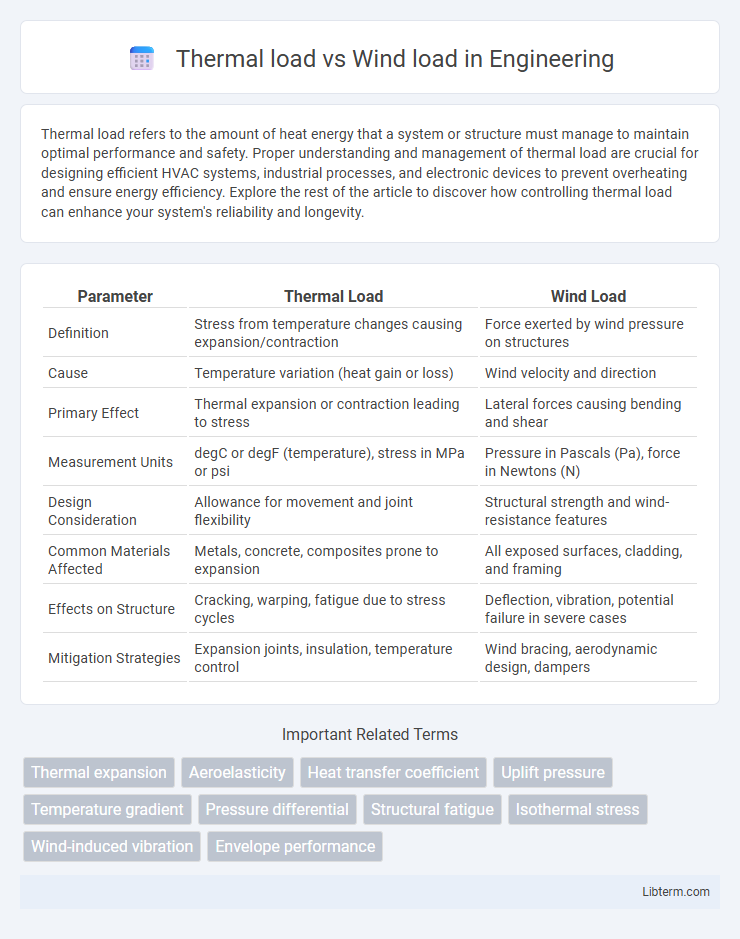Thermal load refers to the amount of heat energy that a system or structure must manage to maintain optimal performance and safety. Proper understanding and management of thermal load are crucial for designing efficient HVAC systems, industrial processes, and electronic devices to prevent overheating and ensure energy efficiency. Explore the rest of the article to discover how controlling thermal load can enhance your system's reliability and longevity.
Table of Comparison
| Parameter | Thermal Load | Wind Load |
|---|---|---|
| Definition | Stress from temperature changes causing expansion/contraction | Force exerted by wind pressure on structures |
| Cause | Temperature variation (heat gain or loss) | Wind velocity and direction |
| Primary Effect | Thermal expansion or contraction leading to stress | Lateral forces causing bending and shear |
| Measurement Units | degC or degF (temperature), stress in MPa or psi | Pressure in Pascals (Pa), force in Newtons (N) |
| Design Consideration | Allowance for movement and joint flexibility | Structural strength and wind-resistance features |
| Common Materials Affected | Metals, concrete, composites prone to expansion | All exposed surfaces, cladding, and framing |
| Effects on Structure | Cracking, warping, fatigue due to stress cycles | Deflection, vibration, potential failure in severe cases |
| Mitigation Strategies | Expansion joints, insulation, temperature control | Wind bracing, aerodynamic design, dampers |
Introduction to Structural Loads
Structural loads are critical in designing safe buildings, with thermal load and wind load being two primary types that influence structural integrity. Thermal load refers to stresses caused by temperature changes leading to expansion or contraction of materials, while wind load involves forces exerted by wind pressure on structures. Understanding the magnitude and distribution of these loads ensures buildings can withstand environmental stresses without failure or excessive deformation.
Defining Thermal Load
Thermal load refers to the stress imposed on structures due to temperature variations causing expansion or contraction of materials. Unlike wind load, which results from aerodynamic forces acting on exposed surfaces, thermal load is primarily influenced by environmental temperature changes and solar radiation. Understanding thermal load is essential for designing buildings and bridges to accommodate material deformation and prevent structural damage.
Understanding Wind Load
Wind load refers to the pressure exerted by wind on structures, significantly affecting building design and safety standards. It varies with wind speed, direction, shape, and location of the structure, making accurate assessment crucial for structural integrity. Understanding wind load involves analyzing dynamic forces to ensure resilience against potential damage from storms and high-speed winds.
Key Differences: Thermal vs Wind Load
Thermal load refers to the stress and deformation experienced by materials due to temperature changes causing expansion or contraction, while wind load involves the forces exerted on structures by wind pressure and velocity. Thermal loads typically result in gradual material strain, often affecting expansion joints and causing buckling, whereas wind loads are dynamic, fluctuating rapidly and imposing lateral and uplift forces that demand structural stability against overturning. Engineers prioritize thermal load analysis for temperature-sensitive components and wind load calculations for designing resistance against gust-induced stresses in buildings and bridges.
Impact of Climate on Load Assessment
Thermal load and wind load significantly influence structural load assessment, with climate playing a pivotal role in their variation. In regions experiencing extreme temperature fluctuations, thermal expansion and contraction impose cyclic stresses on materials, while coastal or storm-prone areas face elevated wind loads due to intense atmospheric pressure and velocity. Accurate load assessment requires integrating local climate data, including seasonal temperature ranges and wind speed histograms, to ensure structural resilience and safety.
Calculation Methods for Thermal Load
Thermal load calculation methods primarily involve assessing temperature-induced expansion or contraction of building materials using formulas based on the coefficient of thermal expansion and temperature variation data. These calculations require detailed input on material properties, environmental temperature ranges, and structural constraints to determine stresses and deformations accurately. Finite element analysis (FEA) software is commonly employed to simulate thermal effects, enabling precise modeling of thermal loads in complex structures.
Calculation Methods for Wind Load
Wind load calculation methods primarily involve using standards like ASCE 7 and Eurocode EN 1991-1-4, which prescribe formulas based on factors such as wind speed, exposure category, and building geometry. These methods incorporate dynamic pressure calculations, which consider wind velocity pressure, gust factors, and importance factors to determine lateral forces on structures. Accurate assessment requires site-specific data, including topography and terrain roughness, to refine wind pressure distributions and ensure structural safety against wind-induced effects.
Material Response to Thermal and Wind Loads
Thermal load induces expansion or contraction in materials, leading to stress due to temperature gradients, which can cause deformation or cracking over time. Wind load applies dynamic pressure, resulting in bending, shear, and fluctuating stresses that impact structural stability and fatigue resistance. The material's elasticity, thermal conductivity, and fatigue strength determine its response and durability under combined thermal and wind loads.
Design Strategies for Combined Loads
Design strategies for combined thermal load and wind load focus on ensuring structural resilience by integrating flexible materials and expansion joints that accommodate thermal expansion while maintaining stability against wind pressure. Engineers use advanced simulations to model the interaction of thermal stresses and dynamic wind forces, optimizing support systems and load paths to prevent structural fatigue and failure. Incorporating adaptive facade systems and airflow management techniques can further mitigate the impact of simultaneous thermal and wind loads on buildings and bridges.
Future Trends in Structural Load Analysis
Future trends in structural load analysis emphasize advanced modeling techniques incorporating thermal load variations caused by climate change and urban heat islands alongside dynamic wind load effects intensified by extreme weather patterns. Integration of machine learning algorithms and high-resolution simulation software enables real-time assessment of temperature-induced stress and aerodynamic forces for resilient structural design. Innovations in sensor technology and IoT-driven monitoring facilitate adaptive load management, optimizing material performance and enhancing the safety and durability of infrastructure under fluctuating thermal and wind conditions.
Thermal load Infographic

 libterm.com
libterm.com